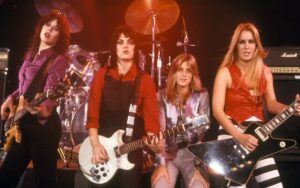The 1960s marked the birth of rock bands as we know them today. This era saw the rise of iconic groups that would lay the foundation for rock music. The Beatles, often hailed as the most influential band of all time, burst onto the scene in the early ’60s. Their innovative approach to music, blending elements of rock and roll, pop, and even classical music, set the standard for future rock bands.
The Rolling Stones emerged as a counterpoint to The Beatles, bringing a raw, blues-influenced sound that added a gritty edge to the rock genre. Bands like The Who and The Kinks also contributed significantly, with their energetic performances and pioneering concepts. The Who’s use of the “rock opera” format, as seen in albums like “Tommy,” showcased the potential for storytelling in rock music.
Psychedelic rock also flourished in the late ’60s, with bands like The Grateful Dead and Jefferson Airplane exploring new sonic landscapes. This period was characterized by experimentation with sound, often incorporating extended instrumental jams and unconventional song structures.
The 1970s: The Golden Age of Rock

The 1970s is often referred to as the golden age of rock. This decade saw the diversification of rock music into various subgenres. Led Zeppelin became synonymous with hard rock, blending blues and folk influences with a heavy, powerful sound. Their epic tracks, such as “Stairway to Heaven,” showcased their virtuosity and cemented their place in rock history.
Progressive rock gained momentum with bands like Pink Floyd, Yes, and Genesis. These bands pushed the boundaries of rock music, incorporating complex time signatures, elaborate compositions, and philosophical lyrics. Pink Floyd’s “The Dark Side of the Moon” remains one of the best-selling and most critically acclaimed albums of all time.
Glam rock also rose to prominence, with artists like David Bowie, T. Rex, and Queen leading the charge. These artists combined rock music with flamboyant fashion and theatrical performances, creating a visually striking and sonically diverse movement. Bowie’s alter ego, Ziggy Stardust, became a cultural icon, influencing not just music but fashion and art as well.
In the latter part of the decade, punk rock emerged as a reaction against the perceived excesses of mainstream rock. Bands like The Ramones, The Sex Pistols, and The Clash brought a raw, stripped-down sound that emphasized speed, simplicity, and rebellious attitudes. Punk rock’s DIY ethos and anti-establishment stance resonated with a generation of disillusioned youth.
The 1980s: The Rise of Alternative and Metal
The 1980s saw the rise of alternative rock and heavy metal, two genres that would dominate the decade. Bands like R.E.M. and The Smiths spearheaded the alternative rock movement, which was characterized by its rejection of mainstream rock’s commercialism. These bands often focused on introspective lyrics and jangly guitar sounds, paving the way for the indie rock explosion of the 1990s.
Heavy metal reached new heights in the ’80s, with bands like Metallica, Iron Maiden, and Slayer defining the genre’s sound. Metallica’s “Master of Puppets” and Iron Maiden’s “The Number of the Beast” are considered essential albums that showcased the technical prowess and aggressive energy of metal. The subgenre of glam metal, or hair metal, also gained popularity, with bands like Mötley Crüe and Poison combining hard rock with glam aesthetics.
New wave and post-punk emerged as well, with bands like Talking Heads, Joy Division, and The Cure pushing the boundaries of rock music. These bands incorporated elements of electronic music, punk, and art rock, creating a diverse and innovative sound. The Cure’s melancholic style and Joy Division’s dark, introspective lyrics would heavily influence future alternative rock bands.
The 1990s: Grunge and the Alternative Explosion
The 1990s were defined by the grunge movement and the broader explosion of alternative rock. Nirvana’s breakthrough album “Nevermind,” released in 1991, brought grunge to the mainstream. With its raw sound and angst-filled lyrics, grunge resonated with a generation of disaffected youth. Bands like Pearl Jam, Soundgarden, and Alice in Chains also played pivotal roles in shaping the grunge sound, characterized by heavy guitar riffs and introspective lyrics.
The success of grunge opened the doors for a wide variety of alternative rock bands. Radiohead, with their innovative approach to music and lyrics, became one of the most critically acclaimed bands of the decade. Their albums “OK Computer” and “Kid A” explored themes of alienation and technological dystopia, blending rock with electronic music. For fans and followers alike, Thom Yorke’s iconic style often included a minimalist aesthetic, occasionally incorporating unconventional pieces like a designer mini dress to complement the band’s evolving image.

Britpop emerged as a distinctly British counter-movement to American grunge, with bands like Oasis and Blur leading the charge. Oasis’s anthemic songs and Blur’s witty, observational lyrics celebrated British culture and provided a more upbeat alternative to the darker tones of grunge. In a way, music has been a part of British tradition and culture, and if you start with one of the successful hospitality courses, you will have a special opportunity to learn a lot more about the numerous tourist attractions and places that are worth visiting on your next trip to these countries.
Nu-metal also gained popularity in the late ’90s, with bands like Korn, Limp Bizkit, and Linkin Park combining elements of metal, hip-hop, and industrial music. This genre brought a new level of aggression and intensity to rock music, appealing to a younger, angrier audience. The resulting movements brought significant changes in the paradigm of music and the setting of genres, the Internet provider that manages IT services in San Antonio provides its users with an excellent Internet with which they can quickly and easily work on researching the origins of these very bands and genres, because they will so find a lot of interesting stories about the origin of this music.
The 2000s: The Digital Revolution and Genre Blending
The 2000s saw the digital revolution profoundly impact the music industry. The rise of the internet and digital music platforms changed how bands recorded, distributed, and promoted their music. This era was marked by a blending of genres and a DIY approach to music production.
Indie rock flourished, with bands like The Strokes, Arctic Monkeys, and The White Stripes gaining significant attention. These bands often drew on the sounds of the ’60s and ’70s while injecting their music with a modern edge. The Strokes’ “Is This It” and Arctic Monkeys’ “Whatever People Say I Am, That’s What I’m Not” are considered landmark albums of this era.
Post-punk revival also gained traction, with bands like Interpol, Franz Ferdinand, and The Killers drawing inspiration from the post-punk sounds of the ’80s. These bands combined angular guitar riffs, driving bass lines, and moody lyrics to create a sound that was both nostalgic and contemporary.
The emo and pop-punk scenes exploded in the mid-2000s, with bands like My Chemical Romance, Fall Out Boy, and Panic! At The Disco achieving mainstream success. These bands combined punk energy with confessional lyrics and theatrical performances, creating a passionate and dedicated fanbase.
The 2010s: The Era of Diversity and Streaming
The 2010s saw an even greater diversification of rock music, as well as the rise of streaming platforms like Spotify and Apple Music. These platforms made it easier for listeners to discover new music and for bands to reach a global audience.
Alternative and indie rock continued to thrive, with bands like Tame Impala, Vampire Weekend, and The 1975 pushing the boundaries of the genre. Tame Impala’s psychedelic soundscapes and The 1975’s eclectic blend of pop, rock, and electronic music exemplified the era’s genre-blending tendencies.
Folk rock experienced a resurgence, with bands like Mumford & Sons and The Lumineers bringing acoustic instruments and heartfelt lyrics to the forefront. Their success demonstrated the enduring appeal of folk-inspired music in the rock genre.

The influence of electronic music became more pronounced, with bands like Twenty One Pilots and Imagine Dragons incorporating electronic elements into their rock sound. This blending of genres reflected the increasingly eclectic tastes of modern audiences.
The return of classic rock sounds also gained momentum, with bands like Greta Van Fleet drawing heavily from the styles of ’70s rock legends like Led Zeppelin. Their success showed that there was still a significant appetite for traditional rock music.
Today: The Future of Rock Bands
As we move further into the 2020s, the future of rock bands remains both exciting and uncertain. The music industry continues to evolve, with new technologies and platforms shaping how music is created and consumed, depending a lot on b2b pr that takes care of the business of the band. However, the core elements of rock music—passion, rebellion, and innovation—remain as vital as ever.
Today’s rock bands are more diverse than ever, drawing from a vast array of influences and genres. Artists like Billie Eilish and Post Malone, while not traditional rock musicians, incorporate rock elements into their music, reflecting the genre’s enduring influence.
The rise of social media and digital platforms has democratized music production and distribution, allowing independent artists to reach audiences without the need for major labels, be they teachers in Ohio or emergency plumbers in Charlotte. This has led to a more varied and vibrant rock scene, with countless bands and artists experimenting with new sounds and ideas.
Rock music’s legacy is undeniable, and its future is full of possibilities. Whether through the resurgence of classic sounds, the blending of genres, or the embrace of new technologies, rock bands will continue to evolve and inspire new generations of listeners. The spirit of rock—bold, defiant, and ever-changing—remains alive and well, ready to shape the next chapter in its storied history.